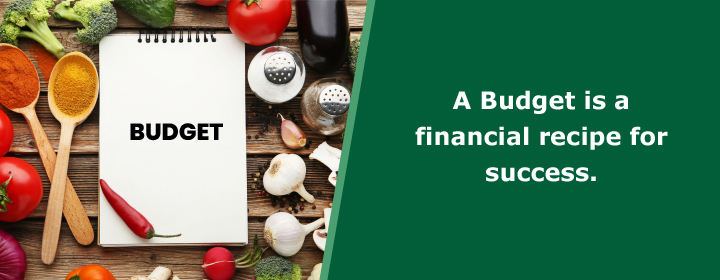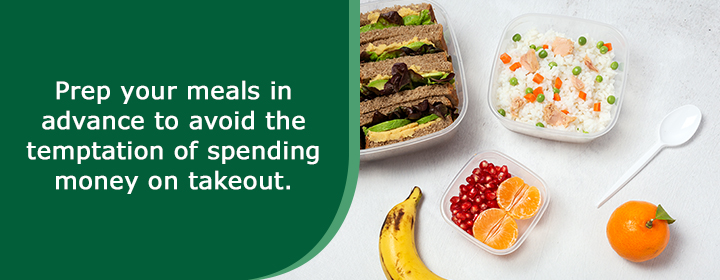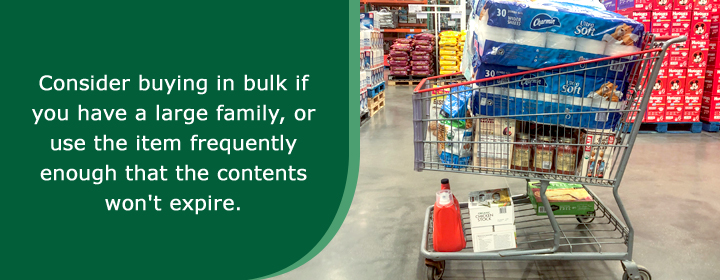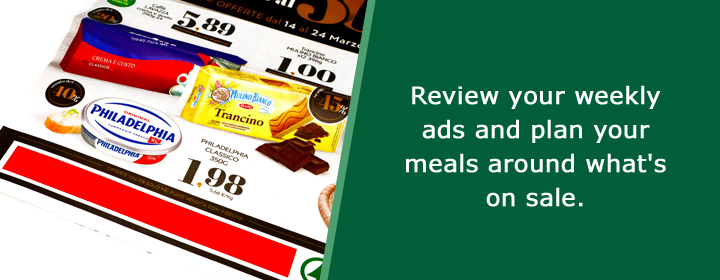Are you looking to reduce your spending? Food can be a large spending category for many people. Whether you want to cook more at home, eat healthier, find ways to cut costs, or all of the above, these four healthy food habits can help you feel better in body and wallet.

1. Home Sweet Home: The Financial Benefits of Eating In
- Monthly budget, you say? If you don’t have a budget, make one today! It’s easy. And, to keep the focus of our article on food, we’ll say that a budget is simply a financial recipe for success. It’s a plan that allows you to simply begin with the income you have on hand each month, then measure out how much you need to spend on certain things and how much you can spend on others.
- Make meals ahead of time to save time and money. Meal prep days have become pretty popular, and they can help you get your cooking done days in advance so that you have more time for other activities. Plus, when you know what you’re going to eat and when you’re going to eat it — and you know that your meal’s already been prepared — you’re less apt to change course and pay someone else to make something for you.

2. Budget-Friendly Bites: How to Eat Cheap Without Compromising Quality
3. Nutrition and Savings: The Art of Eating Better for Less
-
No matter where you are, start with healthy food choices. That means focusing on variety, nutrient density, and amount. Nutrition density is critical. You’ll feel full longer when you eat foods that are actually good for you. Here are a few examples.
-
Instead of Snickers, skip the sugar (which makes up most of the bar itself), and satisfy yourself with a handful of peanuts.
-
Skip on refined-grain bread and slice up whole-grain choices instead.
-
Like the color orange? Carrots will keep you full a lot longer than cheese puffs.
-
Cut out “grazing”. Just like you budget your food costs, budget when you eat as well. Having lots of these carb- and sugar-loaded snacks around the house will only cause you to feel less hungry at dinner time (or not eat leftovers from meals you’ve already cooked.) When leftovers go bad, you throw them away — and in essence, you’re throwing away the money it cost to make those meals, too. Stick to a healthy eating plan, drink lots of water, and you’ll feel full all day.

4. Smart Shopping 101: Strategies for Healthier and Cheaper Groceries
When it comes to food costs, another budget-buster is lack of preparation. Knowing what you’re going to buy before you go to the store — then sticking to those items — can help you spend on only the things you’ve planned for. (There’s a reason those prepackaged cookies and snacks we just talked about are always in arm’s reach — impulse buys like these stretch your belly and your budget.)
- The Spend Smart. Eat Smart program can help set you up for success by planning meals and snacks in a way that works for your family, your budget, and your schedule. It includes five-day meal planning worksheets and step-by-step guidelines to help you make the most of each meal, starting with what you already have at home.
- Look for the best deals. If you’re like us, you get a stack of grocery store flyers in your mailbox every. single. week. So, when this week’s ads arrive, actually take a look at them, then plan your meals around what’s on sale! You can print or clip coupons (or use digital versions) to save even more. Even if it means buying certain items at one store and others at another, the extra time you might spend shopping could pay big dividends.
- Generic items have come a long way — in fact, many of them are packaged at the same factory (on the same lines) as their name-brand counterparts that cost two, three, or even five times as much. Many retailers even offer money-back satisfaction guarantees on their store brands. So, if you’re trying to cut costs, don’t behold yourself to a particular brand — it’s keeping you from cashing in. Try out the “no-name” and store brands and save.
- That mindset goes for stores, too. Just because your favorite grocery store is close to home doesn’t mean that it’s the one that offers you the best value — ads or no ads. Taking a short drive to a store that’s a little further away might mean significant savings. Take Trader Joe’s, for instance. Although this fancy, millennial-friendly grocery doesn’t have any West Virginia locations, its older brother, Aldi, sure does. Both are chock-full of quality, great-tasting store-brand items, yet Aldi will save you tons of money, even compared to other traditional grocers like Kroger, Food Lion, and even Wal-Mart.
- Buy in bulk. Whether you belong to a warehouse club like Costco or Sam’s Club or just buy the biggest packages your local stores (or online vendors like Amazon) have to offer, buying in bulk helps you save money per pound or unit. For example, I recently visited my local Food Lion and saw a six-pack of Charmin Ultra Soft on sale for $8.59. That’s $1.43 per roll. The 12-pack cost more ($12.99), but the price per roll dropped to $1.08.
We know buying in bulk isn’t a money-saving option for every family, but it does work for certain situations and can save you multiple trips to the grocery store for frequently used items. After all, no one wants to find out they’re out of toilet paper, right?
Although we can’t cook for you, our mission at Jefferson Security Bank is to enhance your lives and enrich our communities through a wide variety of financial resources and financial education. For more information, give us a call at 304-876-9000, send us an email, or visit one of Charles Town, Inwood, Martinsburg, Shepherdstown, or Sharpsburg (MD) locations today.


